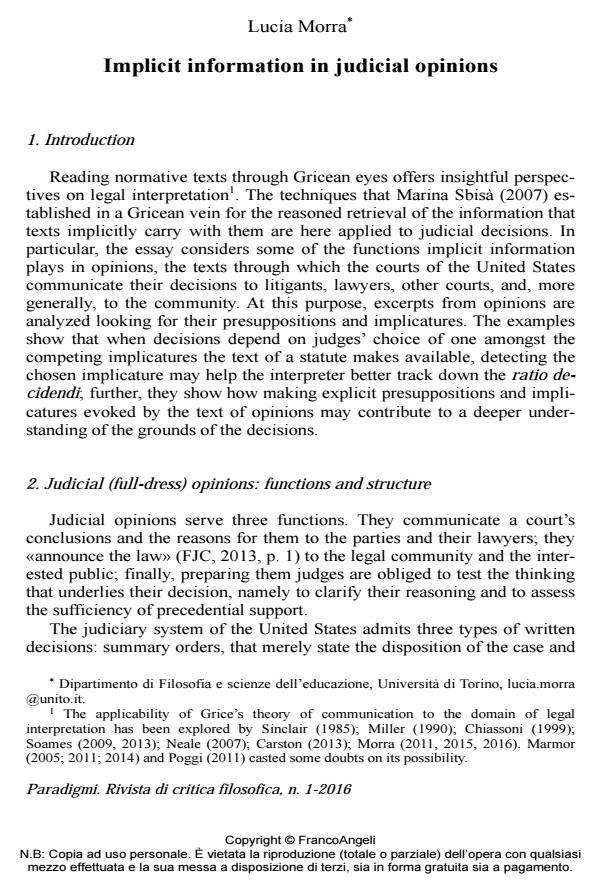Implicit information in judicial opinions
Titolo Rivista PARADIGMI
Autori/Curatori Lucia Morra
Anno di pubblicazione 2016 Fascicolo 2016/1
Lingua Inglese Numero pagine 18 P. 81-98 Dimensione file 213 KB
DOI 10.3280/PARA2016-001007
Il DOI è il codice a barre della proprietà intellettuale: per saperne di più
clicca qui
Qui sotto puoi vedere in anteprima la prima pagina di questo articolo.
Se questo articolo ti interessa, lo puoi acquistare (e scaricare in formato pdf) seguendo le facili indicazioni per acquistare il download credit. Acquista Download Credits per scaricare questo Articolo in formato PDF

FrancoAngeli è membro della Publishers International Linking Association, Inc (PILA)associazione indipendente e non profit per facilitare (attraverso i servizi tecnologici implementati da CrossRef.org) l’accesso degli studiosi ai contenuti digitali nelle pubblicazioni professionali e scientifiche
The essay applies to judicial decisions the techniques Sbisà (2007) established for retrieving information that texts implicitly carry with them. In order to consider the functions implicit information plays in these kinds of texts, excerpts from opinions are analyzed looking for their presuppositions and implicatures. The examples show that when decisions depend on judges’ choice of one amongst the competing implicatures the text of a statute makes available, detecting the chosen implicature may help the interpreter better track down the ratio decidendi; further, they show that making explicit presuppositions and implicatures evoked by the text of opinions may contribute to a deeper understanding of the grounds of the decisions.
Il saggio applica alle sentenze gli strumenti elaborati da Sbisà (2007) per estrarre in modo ragionato gli impliciti che i testi portano con sé. Per individuare le funzioni svolte dall’informazione veicolata implicitamente in questo tipo di testi, sono esplicitate presupposizioni e implicature di alcuni brani tratti da judicial opinions. L’analisi mostra che quando le decisioni dipendono dalla scelta dei giudici di una delle implicature rese disponibili da un testo normativo, individuare quella effettivamente scelta aiuta l’interprete a seguire meglio il ragionamento della corte; inoltre, mostra che esplicitare presupposizioni e implicature suggerite dal testo delle opinions può consentire una comprensione più profonda delle motivazioni delle sentenze.
Parole chiave:Implicature conversazionali, impliciti, interpretazione giuridica, leggi, presupposizioni, sentenze.
- Chiassoni P. (1999). Interpretive Games: Statutory Construction Through Gricean Eyes. In: Comanducci P. e Guastini R., a cura di. Analisi e diritto 1999. Ricerche di giurisprudenza analitica. Torino: Giappichelli: 79-99.
- Elisa B. v. Superior Court, 37 Cal.4th 108 (Cal 2005), 117 P.3d 660, 33 Cal.Rptr.3d 46:
- http://web.lexisnexis.com/research/xlink?app=00075&view=full&interface=1&docinfo=off&searchtype=get&search=37+Cal.+4th+108
- Elisa Maria B. v. Superior Court, 118 Cal. App. 4th 966 (2004): http://www.courts.ca. gov/opinions/revpub/C042077.PDF
- Endicott T. (2005). The Value of Vagueness. In: Bhatia V.K. et al., eds., Vagueness in normative texts. Bern: Peter Lang: 27-48.
- Federal Judicial Center (2013). Judicial Writing Manual: A Pocket Guide for Judges. http://www.fjc.gov/public/pdf.nsf/lookup/judicial-writing-manual-2d-fjc-2013.pdf/$file/judicial-writing-manual-2d-fjc-2013.pdf
- Grice H.P. (1975). Logic and conversation. In Cole P. and Morgan J.L., eds., Syntax and Semantics, Vol. 3: Speech Acts. New York: Academic Press: 41-58.
- Marmor A. (2005). Interpretation and Legal Theory: revised second edition. Oxford and Portland: Hart Publishing. [First edition: Interpretation and Legal Theory, Oxford: Oxford University Press, The Clarendon Law Series, 1992]
- Id. (2008). What Does the Law Say? Semantics and Pragmatics in Statutory Language. In: Comanducci P. e Guastini R., a cura di. Analisi e diritto 2007. Ricerche di giurisprudenza analitica, Torino: Giappichelli: 127-140.
- Id. (2011). Can the Law Imply More than it Says? On some pragmatic aspects of strategic speech. In: Marmor A. and Soames S., eds. Philosophical Foundations of Language in the Law. Oxford: Oxford University Press: 83-97.
- Id. (2014). The Language of Law. Oxford: Oxford University Press.
- Miller G.P. (1990). Pragmatics and the Maxims of Interpretation. Wisconsin Law Review, 1179: 1179-1227.
- Morra L. (2010). New Models for Language Understanding and the Cognitive Approach to Legal Metaphors. International Journal for the Semiotics of Law, 23, 4: 387-405.
- Id. (2011). Implicature conversazionali nei testi di legge. Esercizi filosofici, 6, 1: 214-231.
- Id. (2015). Genitorialità californiana. In: Morra L. e Pasa B., a cura di. Questioni di genere nei testi normativi: impliciti e crittotipi, Torino: Giappichelli: 181-200.
- Id. (2016). Conversational Implicatures in Normative Texts. In: Mey J.L. and Capone A., eds., Interdisciplinary Studies in Pragmatics, Culture and Society. Dordrecht: Springer.
- Morra L. and Pasa B., a cura di (2015). Questioni di genere nei testi normativi: impliciti e crittotipi. Torino: Giappichelli.
- Neale S. (2007). On Location. In: O’Rourke M. and Washington C., eds., Situating Semantics: Essays in Honor of John Perry. Cambridge: MIT Press: 251-393.
- Pasa B. (2015). Dal crittotipo all’implicito: diritto tacito, muto, vissuto? In: Morra L. e Pasa B., a cura di. Questioni di genere nei testi normativi: impliciti e crittotipi. Torino: Giappichelli: 52-69.
- Poggi F. (2008), Semantics, Pragmatics, and Interpretation: A Critical Reading of Some of Marmor’s Theses. In: Comanducci P. e Guastini R., a cura di. Analisi e diritto 2007. Ricerche di giurisprudenza analitica. Torino: Giappichelli: 159-178.
- Id. (2011). Law and Conversational Implicatures. International Journal for the Semiotics of Law, 24, 1: 21-40.
- Sbisà M. (2007). Detto non detto. Le forme della comunicazione implicita. Roma-Bari: Laterza.
- Id. (2015). Normatività e comunicazione. In: Morra L. e Pasa B., a cura di. Questioni di genere nei testi normativi: impliciti e crittotipi. Torino: Giappichelli: 15-37.
- Sinclair M.B.W. (1985). Law and Language: the Role of Pragmatics in Statutory Interpretation. The University of Pittsburgh Law Review, 46: 373-415.
- Smith v. United States, 508 U.S. 223 (1993): https://supreme.justia.com/cases/ federal/us/ 508/223/case.html
- Soames S. (2009). Interpreting Legal Texts: What is, and What is not, Special about the Law. In: Soames S. Philosophical Essays. 1: Natural language: What it Means and How We Use It. Princeton: Princeton University Press: 403-424.
- Id. (2013). Deferentialism: A Post-Originalist Theory of Legal Interpretation. Fordham Law Review, 82, 2: 597-617.
- Strunk W. Jr. and White E.B. (2000). The Elements of Style (4th ed.). Harlow: Pearson Education Limited.
- Pragmatics and Law Lucia Morra, pp.201 (ISBN:978-3-319-30383-3)
Lucia Morra, Implicit information in judicial opinions in "PARADIGMI" 1/2016, pp 81-98, DOI: 10.3280/PARA2016-001007